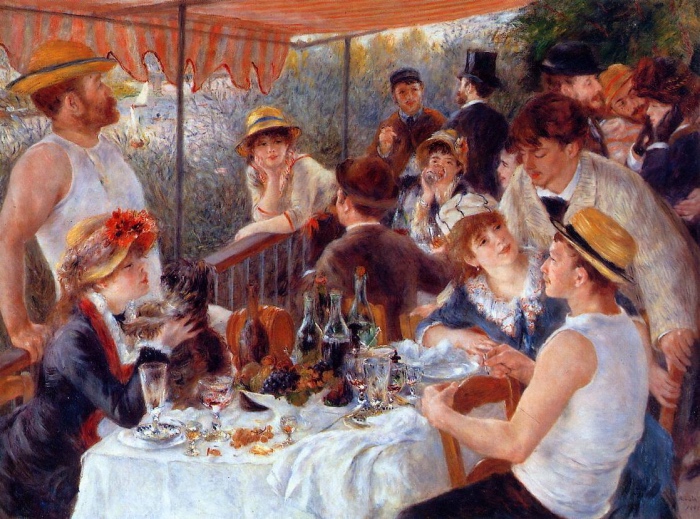IMPRESSIONISM
Impressionism. On April 15th 1874 in Paris at the studio of the photographer Nadar a group of young artists of the Sociètè anonyme coopèrative des artistes peintres sculpteurs et graveurs (Anonymous Society of Painters, Sculptors, and Engravers) presented an art exhibition. Those artists were: Claude Monet, Edgar Degas, Alfred Sisley e Pierre Auguste Renoir.
Their exhibition was a failure, but it was the first Impressionist exhibition.
IMPRESSIONISM

Pierre-Auguste Renoir, Luncheon of the Boating Party, 1880–1881 – Philips Collection Washington.
MEANING OF THE WORD: IMPRESSIONISM
The word Impressionism was coined on that occasion, and it was used with the aim of disapproving and despising these artists’ artworks.
The word derives specifically from the title of Claude Monet’s painting “Impression. Soleil levant” (“Impression. Sunrise”), which represents a landscape not as it appears, but as the artist could see it.
The revolution of Impressionism is representing the beauty of the world without finding refuge in historical or mythological events, as the traditional painting had done until then.
Actually, the 1874 exhibition was the first public launch of a work of a group of artists begun a few years earlier (between 1860 and 1870), and which contrasted with academic painting, showing blurry and confused paintings, not painted inside a studio.
REVOLUTION OF IMPRESSIONISM
The Impressionists promoted a new style of painting and would transform art world within a few decades.
In 1910 the exhibition which marked the crisis of Impressionism was held, as I described in the post dedicated to Post-Impressionism, which is the following phase of this artistic movement.
The Impressionist artworks describe contemporary life in cafés, in streets, in countryside, in landscapes, in nightspots, which were painted by artists looking at the scene.
The great revolution of Impressionism, in fact, is “en plein air” painting, that is open air painting.
The Impressionists painted outdoor, using a portable easel and oil colours in tubes, bringing the painting outside the artist’s studio.
The revolution of Impressionism and its importance consist of going outside in order to look at the world, and put it on canvas, describing the effects of light at different times of days.
Impressionist painting technique consists of applying the paint with rapid brushstrokes, placing colours side by side as tiny spots. Even shadows become important in Impressionist paintings: greys and dark tones are produced by mixing different shades of colours, avoiding the use of black paint. The artists create a sort of coloured shadows.
The different personalities among the group of the Impressionists originated various interpretations of the style they had to use, so much so that around 1880 Claude Monet would throw into crisis “en plein air” landscape painting.
He begun producing Series paintings, such as the cycle of 31 paintings devoted to Rouen Cathedral I’ve already showed, started in front of the subject but finished inside his studio.
Monet, in this way, threw into crisis Impressionism, and created paintings where artist’s inner vision prevailed over optical vision, paving the way to abstract painting.

Alfred Sisley, The effect of snow at Argenteuil (1874).jpg
Follow me on:
About me
In this blog, I don't explain the history of art — I tell the stories that art itself tells.


